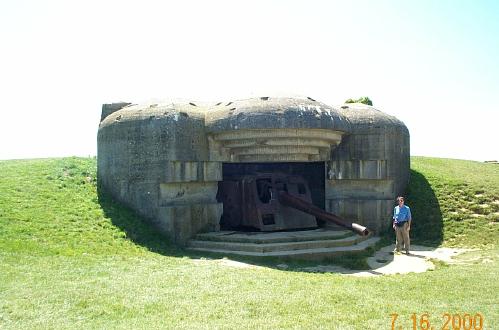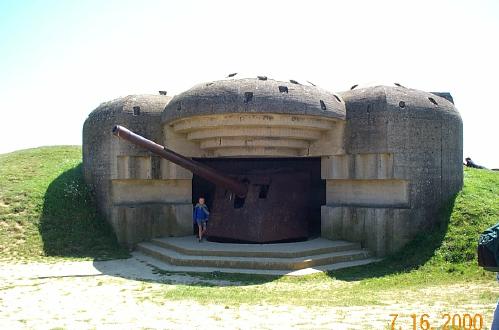
Wind Buggies On Omaha Beach

Today the weather returned to "normal" partly cloudy 75 degrees with gusty winds along the coast. Much like northern California beach weather. We drove from Mt. St. Michel to Bayeux, and got settled in our hotel in the early afternoon. This left time to visit a few D-Day sites before dinner.
First we visited Omaha beach, and the monuments on the hills rising from the beach. Today Omaha beach looks like any other northern beach. People enjoy flying kites, playing in the water, and riding wind surfing carts on the beach. The only indication of what occurred 50 years ago is the occasional marker, and the number of visitors in the steep hills behind the beach. From looking up the hills from the beach, it's easy to see why Omaha beach cost the most lives of all the invasion beaches. The hills are steep, the beach is wide open, and the hills were well defended with German guns.

Wind Buggies On Omaha Beach |
The road that winds up the hill past the monuments next lead us to the Normandy American Cemetery. This is one of the few American military cemeteries that are maintained on foreign ground by the United States.

American Cemetary At Omaha Beach |

Statue At American Cemetary |
Next we visited the United States Ranger's memorial on Pointe Du Hoc, where the rangers scaled the 100-foot cliffs to take control of a German gun base. We learned that keeping control of this strategic gun base was much more expensive in human terms than initially taking it, because it wasn't very well manned initially. However when the Germans figured out the scope of the attack, they pored lots of resources into trying to retake the point. By the time the point and a position inland was finally secured, over half the Americans who landed here were dead.

Cliffs At Pointe Du Hoc |

German Bunker At Pointe Du Hoc |

Pitted Landscape Of Pointe Du Hoc |
After these visits we called it quits for the night - in the last 2 days we have put 600k (360 miles) on the car. Although this would be beautiful country to cycle in, I think getting a car for this portion of the journey was a good idea.
This morning we had a leisurely breakfast and visited the Bayeux Tapestry to break our visits to D Day sites. This 60 meter long tapestry was commissioned to show the conquests of William the Conquerors invading England. This historic story was created sometime between 1066 and 1087 to decorate the nave of the Cathedral at Bayeux. It is very significant because it is considered one of the oldest works of European art still in existence today. In addition to creatively illustrating the story of William's conquests it also provides a very unique illustration of medieval life.
I found it humorous that William the Conqueror was known as William the Bastard in England during his lifetime because his mother and his royal father were never married. To this day opinions are still split depending on which side of the channel you are. The French think he's a hero that stormed England from the shores of Normandy. The English on the other hand see him as a ruthless invader whose reign of the country was tumultuous until its eventual demise.
Next we jumped back in the car and headed back to the D Day landing beaches. We visited the German big guns station at Longues Sur Mer. This station housed 4 long-range guns that could fire on Omaha, Gold, and Juno beach as well as the ships at sea. These 4 guns were placed about 300 meters back from the edge of a cliff and were sited by a hardened targeting center that had a strategic overlooked the both the sea, and the coast from the edge of a cliff. The Alied forces worked hard for nearly two days both from the air, and from ship before these powerful guns fell silent.

John At Gun German Gun Bunker At Longes Sur Mer |

Another Gun Bunker At Longes Sur Mer |

Hardened Aiming Center At Longes Sur Mer |
After seeing the big guns, we moved on to Arrowmanches to learn about a part of D Day history that neither Dorothy nor I had ever heard about. Arrowmanches is the site where a portable port was setup to supply the invasion fleet that landed on D Day. This amazing feat which was the brain child of Winston Churchill, who knew that the Germans held all of the French ports so strongly that there was little chance of winning one of them as a place to supply the invading troops. The idea was to build a Lego block style floatable port in secret that could be towed across the English Channel and then sunk to form a port capable of supplying the war against Germany. The D Day operations included two of these experimental ports, one at Arrowmances, and one at Omaha beach. Unfortunately the one at Omaha didn't hold up past it's initial construction due to the same rough seas that punished the American landing parties before they reached the beaches and the German guns firing down on them from the hilltops. Both Dorothy and I were surprised that neither of us had heard about this critical piece of the D Day operations.

Ruins of Arrowmanches Port |
Next we moved to the flat beach and small dunes of Utah beach, where the American landing troops made progress much more quickly than at Omaha Beach. Unlike Omaha beach, Utah beach has a new modern monument right at the beach to serve as a reminder of the extrodinary events of 1944.

Utah Beach Memorial |
Our last stop of the day was the German cemetery at La Cambe. This large gravesite is the final resting place for 21,000 German soldiers. Many of these graves are simply marked "German Soldier". The strongest message here was the one told by the graves of the many German soldiers whose careers ended here in France at just 17 year of age. A quote from Nobel Piece Prize winner Albert Schweitzer summarized the site well - "Wargraves are the greatest monument to peace."

German Cemetary At La Cambe |
Today we leave the clean little town of Bayeux, which the war, which raged 10k away, somehow left unscathed. However just outside of Bayeux we decided to make one last D-Day stop at the Caen Memorial, which turned out to be very worthwhile. This museum starts by taking you down a long winding ever-darkening path that includes a series of exhibits that take you from the end of World War I, through the end of World War II. It explains the difficult peace after WWI and the economic chaos of the late 1920's that lead to the rise of leaders like Mussolini and Hitler.
In the lower floor of the museum further exhibits show the dark times in France when the Vichy government collaborated with the German army who occupying the country, a little bit about the French resistance, and the small section on the Holocaust.
The tone of the museum changes as the exhibit lead back upstairs and show the globalization of the war, when the Japan, the United States, and the Soviet Union get pulled into the war. The feel of the museum turns more hopeful as the exhibits show the Allied buildup towards the D-Day invasion, and then move toward the end of the war.
The Caen Memorial also includes a Gallery for the Nobel Peace Prize winners. This interesting gallery includes displays about all six disciplines that are rewarded with Nobel Prizes: Medicine, Literature, Chemistry, Economics, Physics, and the quest for peace. It also explained that the how the Nobel Prizes were started. The Swedish chemist and wealthy head of an industrial empire, Alfred Nobel established a trust on his death that would be invested in sound investments, with the annual interest distributed as prize money for outstanding international contributions in each discipline.
This made for a very interesting day before we continued on to Honfleur, which is known as the city of art because of the influence of the impressionist movement that was strongly entrenched her in the late 1800s.